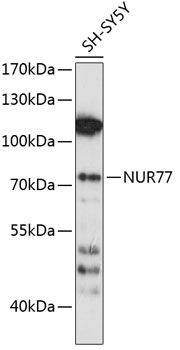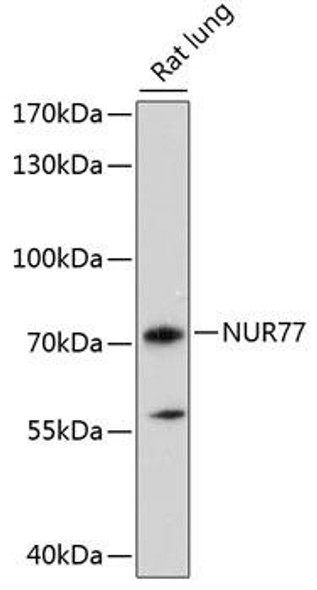Description
Anti-NUR77 Antibody (CAB0843)
The NR4A1 Polyclonal Antibody (CAB0843) is a valuable tool for researchers studying the NR4A1 protein, a member of the nuclear receptor subfamily 4. This antibody, generated in rabbits, shows high reactivity with human samples and has been validated for use in Western blot applications.NR4A1, also known as Nur77 or TR3, is a transcription factor involved in diverse physiological processes such as cell growth, apoptosis, and inflammation. Its dysregulation has been linked to various diseases including cancer, cardiovascular disorders, and autoimmune conditions.
The NR4A1 Polyclonal Antibody enables detection and analysis of NR4A1 expression in different cell types, making it an ideal choice for studies in molecular biology and disease pathology.By utilizing this antibody, researchers can gain valuable insights into the role of NR4A1 in different biological processes and diseases, ultimately leading to a better understanding of its potential as a therapeutic target. Its specificity and reliability make it a valuable tool for advancing research in the field of molecular biology and healthcare.
| Antibody Name: | Anti-NUR77 Antibody |
| Antibody SKU: | CAB0843 |
| Antibody Size: | 20uL, 50uL, 100uL |
| Application: | WB IF |
| Reactivity: | Human |
| Host Species: | Rabbit |
| Immunogen: | Recombinant fusion protein containing a sequence corresponding to amino acids 1-170 of human NUR77 (NP_775180.1). |
| Application: | WB IF |
| Recommended Dilution: | WB 1:500 - 1:2000 IF 1:50 - 1:200 |
| Reactivity: | Human |
| Positive Samples: | SH-SY5Y |
| Immunogen: | Recombinant fusion protein containing a sequence corresponding to amino acids 1-170 of human NUR77 (NP_775180.1). |
| Purification Method: | Affinity purification |
| Storage Buffer: | Store at -20'C. Avoid freeze / thaw cycles. Buffer: PBS with 0.02% sodium azide, 50% glycerol, pH7.3. |
| Isotype: | IgG |
| Sequence: | MPCI QAQY GTPA PSPG PRDH LASD PLTP EFIK PTMD LASP EAAP AAPT ALPS FSTF MDGY TGEF DTFL YQLP GTVQ PCSS ASSS ASST SSSS ATSP ASAS FKFE DFQV YGCY PGPL SGPV DEAL SSSG SDYY GSPC SAPS PSTP SFQP PQLS PWDG SFGH FSPS QTYE GL |
| Gene ID: | 3164 |
| Uniprot: | P22736 |
| Cellular Location: | Cytoplasm, Nucleus |
| Calculated MW: | 33kDa/64kDa/65kDa |
| Observed MW: | 71kDa |
| Synonyms: | NR4A1, GFRP1, HMR, N10, NAK-1, NGFIB, NP10, NUR77, TR3 |
| Background: | This gene encodes a member of the steroid-thyroid hormone-retinoid receptor superfamily. Expression is induced by phytohemagglutinin in human lymphocytes and by serum stimulation of arrested fibroblasts. The encoded protein acts as a nuclear transcription factor. Translocation of the protein from the nucleus to mitochondria induces apoptosis. Multiple transcript variants encoding different isoforms have been found for this gene. |
| UniProt Protein Function: | Nur77: an orphan nuclear receptor and immediate-early gene that regulates cellular proliferation, apoptosis, inflammation, and glucose metabolism. Induced by exercise in muscle and is a functional regulator of glucose metabolism in skeletal muscle. Its level decreases in the muscle of obese insulin-resistant men. Acts concomitantly with NURR1 in regulating the expression of delayed-early genes during liver regeneration. Binds the NGFI-B response element (NBRE) 5'-AAAAGGTCA-3'. May inhibit NF-kappa-B transactivation of IL2. A mediator of TCR-directed thymocyte apoptosis. TCR-signaling induces a FAIM/Akt/Nur77 signaling pathway that is critical for modulating apoptosis in developing thymocytes. A physiological substrate of the MEK-ERK-RSK cascade that modulates nuclear export and intracellular translocation during T cell death. Binds DNA as a monomer. Interacts with GADD45GIP1. Overexpression of Nur77 induces the expression of both p300 and HDAC1. Acetylation by p300 and HDAC1 may regulate the rapid turnover of Nur77 protein. |
| UniProt Protein Details: | Protein type:Nuclear receptor; Apoptosis; DNA-binding Chromosomal Location of Human Ortholog: 12q13 Cellular Component: nucleoplasm; nuclear membrane; cytoplasm; nucleus Molecular Function:protein binding; ligand-dependent nuclear receptor activity; DNA binding; zinc ion binding; sequence-specific DNA binding; steroid hormone receptor activity Biological Process: epidermal growth factor receptor signaling pathway; transcription initiation from RNA polymerase II promoter; phosphoinositide-mediated signaling; intracellular receptor-mediated signaling pathway; fibroblast growth factor receptor signaling pathway; cell migration during sprouting angiogenesis; nerve growth factor receptor signaling pathway; innate immune response; positive regulation of endothelial cell proliferation; positive regulation of transcription from RNA polymerase II promoter; steroid hormone mediated signaling; gene expression; signal transduction |
| NCBI Summary: | This gene encodes a member of the steroid-thyroid hormone-retinoid receptor superfamily. Expression is induced by phytohemagglutinin in human lymphocytes and by serum stimulation of arrested fibroblasts. The encoded protein acts as a nuclear transcription factor. Translocation of the protein from the nucleus to mitochondria induces apoptosis. Multiple transcript variants encoding different isoforms have been found for this gene. [provided by RefSeq, Jan 2011] |
| UniProt Code: | P22736 |
| NCBI GenInfo Identifier: | 127819 |
| NCBI Gene ID: | 3164 |
| NCBI Accession: | P22736.1 |
| UniProt Secondary Accession: | P22736,Q15627, B4DML7, |
| UniProt Related Accession: | P22736 |
| Molecular Weight: | 64,463 Da |
| NCBI Full Name: | Nuclear receptor subfamily 4 group A member 1 |
| NCBI Synonym Full Names: | nuclear receptor subfamily 4, group A, member 1 |
| NCBI Official Symbol: | NR4A1 |
| NCBI Official Synonym Symbols: | HMR; N10; TR3; NP10; GFRP1; NAK-1; NGFIB; NUR77 |
| NCBI Protein Information: | nuclear receptor subfamily 4 group A member 1; ST-59; hormone receptor; TR3 orphan receptor; steroid receptor TR3; testicular receptor 3; early response protein NAK1; orphan nuclear receptor HMR; orphan nuclear receptor TR3; nuclear hormone receptor NUR/77; growth factor-inducible nuclear protein N10; nerve growth factor IB nuclear receptor variant 1 |
| UniProt Protein Name: | Nuclear receptor subfamily 4 group A member 1 |
| UniProt Synonym Protein Names: | Early response protein NAK1; Nuclear hormone receptor NUR/77; Nur77; Orphan nuclear receptor HMR; Orphan nuclear receptor TR3; ST-59; Testicular receptor 3 |
| Protein Family: | Nuclear receptor subfamily |
| UniProt Gene Name: | NR4A1 |
| UniProt Entry Name: | NR4A1_HUMAN |











